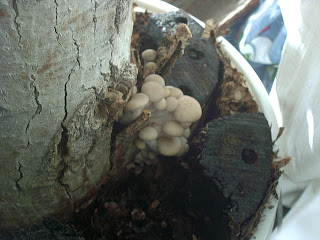The very last diner to the table is the fungi perfecti, the mushroom producing fungus. They come in blown by the wind or they grow to the table through the soil. Either way, it takes them a week or more to get to the table and amass any appreciable size where they can really take advantage of the food. By this time, though, even the scraps are gone. This doesn’t really bug the mushrooms, though. They just settle right in and eat the table.
This mental image is what drives my designs for mushroom habitats. When growing a plant, you want to create the optimum conditions for that plant to grow, thrive, and out-compete whatever competition it will have. The same thing goes for growing mushrooms, remembering that their principal competition will be bacteria and molds. To do that, you need to control some key environmental factors to give the mushrooms the competitive edge.
Temperature
Bacteria typically grow best in warm conditions. That is why your refrigerator is cold. It inhibits the growth of bacteria. The same goes for molds. Tropical mushrooms, like pink oyster and paddy straw mushrooms need warm conditions to grow properly as well. However, most temperate mushrooms are well adapted for cooler temperatures. In nature, they live on the cool forest floor. Many, especially the enoki mushroom (Flamulina velutipes) are so well adapted to the cold that they will continue to grow in any temperature short of actually frozen. It is a strategy that serves them well. Mushrooms that can continue to grow in cooler temperatures can continue to grow and survive when their principal competition has gone dormant. Growing your mushrooms in cooler conditions (though not actually in the fridge) can help them out-compete bacteria and molds.
Moisture
One of the advantages of being a multi-cellular organism is the ability to transport nutrients from where you have them to where you need them. Now fungus isn’t as good at this as us vascular animals, but it can transport water small distances. It can also survive through fairly dry conditions (though complete desiccation will probably kill it) and come back to life when water is again available. Keeping your mushroom just a little damp, but not overly wet, will allow the fungus to grow without giving the bacteria the upper hand.
Food Sources
This is the area where you can really stack the deck in favor of the mushrooms. Many of the best gourmet mushrooms are primary decomposers of wood. That means that they will move into a solid log and consume it. Raw, unprocessed wood is a complete food for mushrooms. Now you could probably get better and faster growth by adding all kinds of additives. Mushrooms like sugar as much as the next organism. However, the more other stuff you add to give it more energy, the more you open the door to other organisms to move in and compete. Keeping the meal as hard to digest as possible gives the mushroom the advantage.
Surface Area
Controlling the surface area of your food source is another way to cut down on contamination in your mushroom cultures. Consider a log vs. a pile of sawdust. The sawdust is much more accessible to the mycelium. The mycelium can grow through it in just a few days and then begin digestion in earnest. On the other hand, the bacteria and molds around can also do that. A fresh log, on the other hand, is a solid block of hard material. The mycelium uses a combination of digestion and hydrostatic pressure to push its way through, but doesn’t leave much room for others to slide in behind it. It may take 6 months for the mycelium to colonize the whole log, but provided it wasn’t contaminated to begin with, you have a good chance it won’t become so in that period of time.
So just consider the various factors that are within your control when you are setting up the growing conditions for your mushrooms. A little tweaking of the conditions could mean the difference between a successful culture and lots of yummy mushrooms and a contaminated failure that is only good for the compost bin.



I Love these magic Mushrooms !!!! WoW !!
ReplyDeletecubensis spores